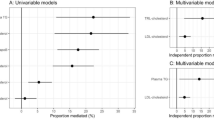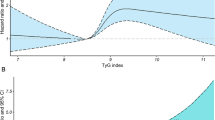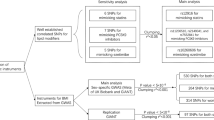Abstract
Mean risk factor levels in various ethnic groups illustrate the potential importance of triglyceride metabolism in the risk for ischemic heart disease (IHD). Serum triglyceride concentrations are a surrogate for a range of potentially atherogenic disturbances in lipoprotein species, including increased concentrations of remnants of VLDL and chylomicron metabolism, increased small, dense LDL concentrations and reduced HDL concentrations. Differences between at-risk groups in lipoprotein profiles reflect alterations in the metabolism of triglycerides that might be greater than differences observed when only circulating triglyceride concentrations are measured. This atherogenic lipoprotein profile is typically found in association with increased visceral fat, insulin resistance and type 2 diabetes and might be a characteristic of Asian Indian ethnicity. By contrast, despite being relatively insulin resistant, Afro-Caribbean men in the UK have a low risk of IHD and lack the adverse lipoprotein profile. This could result from secretion of relatively large proportions of their VLDL as small, triglyceride-poor particles, levels of which are not augmented in response to loss of insulin action. These considerations re-endorse the potential importance of triglyceride metabolism in IHD and present opportunities for identifying useful areas in which drug targets for reducing IHD risk can be sought.
Key Points
-
Mean triglyceride concentrations are the strongest covariate with variation in ischemic heart disease according to ethnicity, sex and diabetes
-
The importance of triglycerides is likely to have been underestimated in risk-factor studies
-
Triglyceride levels provide an index of the atherogenic lipoprotein profile
-
Differences in features of the atherogenic lipoprotein profile according to ethnicity, sex and diabetes might be greater than differences in triglycerides
-
The paradoxical association between insulin resistance, high risk of diabetes, low expression of the atherogenic lipoprotein profile and low risk of ischemic heart disease in Afro-Caribbeans might be explained by their increased secretion of small, triglyceride-poor VLDL
This is a preview of subscription content, access via your institution
Access options
Subscribe to this journal
Receive 12 print issues and online access
$209.00 per year
only $17.42 per issue
Buy this article
- Purchase on Springer Link
- Instant access to full article PDF
Prices may be subject to local taxes which are calculated during checkout



Similar content being viewed by others
References
Wild S and Mckeigue P (1997) Cross sectional analysis of mortality by country of birth in England and Wales, 1970-92. BMJ 314: 705–710
Chaturvedi N et al. (1996) Differences in mortality and morbidity in African Caribbean and European people with non-insulin dependent diabetes mellitus: results of 20 year follow up of a London cohort of a multinational study. BMJ 313: 848–852
UK Prospective Diabetes Study Group (1998) Ethnicity and Cardiovascular Disease. The incidence of myocardial infarction in white, South Asian, and Afro-Caribbean patients with type 2 diabetes (UK Prospective Diabetes Study 32). Diabetes Care 21: 1271–1277
Mather HM et al. (1998) Mortality and morbidity from diabetes in South Asians and Europeans: 11-year follow-up of the Southall Diabetes Survey, London, UK. Diabet Med 15: 53–59
Chaturvedi N et al. (1994) Racial differences in hypertension. BMJ 308: 1634–1635
Zoratti R et al. (2000) Relation of plasma lipids to insulin resistance, non-esterified fatty acid levels and body fat in men from three ethnic groups: relevance to variation in risk of diabetes and coronary disease. Metabolism 49: 245–252
McKeigue PM et al. (1991) Relation of central obesity and insulin resistance with high diabetes prevalence and cardiovascular risk in South Asians. Lancet 337: 382–386
Cooper RS et al. (1997) Prevalence of NIDDM among populations of the African diaspora. Diabetes Care 20: 343–348
Guyton JR et al. (1985) Relationship of plasma lipoprotein Lp(a) levels to race and to apolipoprotein B. Arteriosclerosis 5: 265–272
Seedat YK (1996) Ethnicity, hypertension, coronary heart disease and renal diseases in South Africa. Ethn Health 1: 349–357
Miller GJ et al. (1988) Adult male all-cause, cardiovascular and cerebrovascular mortality in relation to ethnic group, systolic blood pressure and blood glucose concentration in Trinidad, West Indies. Int J Epidemiol 17: 62–69
Fang J et al. (1996) The association between birthplace and mortality from cardiovascular causes among black and white residents of New York City. N Engl J Med 335: 1545–1551
National Institutes of Health, National Heart, Lung and Blood Institute. Morbidity and Mortality: 2004 Chart Book on Cardiovascular Lung and Blood Disease [http://www.nhlbi.nih.gov/resources/docs/04_chtbk.pdf] (accessed 20 December 2006)
Kooner JS et al. (1998) Abdominal obesity, impaired nonesterified fatty acid suppression, and insulin-mediated glucose disposal are early metabolic abnormalities in families with premature myocardial infarction. Arterioscler Thromb Vasc Biol 18: 1021–1026
Laws A et al. (1994) Resistance to insulin-stimulated glucose uptake and dyslipidemia in Asian Indians. Arterioscler Thromb 14: 917–922
Frost GS et al. (1998) Reduced adipocyte insulin sensitivity in Caucasian and Asian subjects with coronary heart disease. Diabet Med 15: 1003–1009
Forouhi NG et al. (1999) Relation of triglyceride stores in skeletal muscle cells to central obesity and insulin sensitivity in European and South Asian men. Diabetologia 42: 932–935
Bhatnagar D et al. (1995) Coronary risk factors in people from the Indian subcontinent living in west London and their siblings in India. Lancet 345: 405–409
Chaturvedi N et al. (1994) Relationship of glucose intolerance to coronary risk in Afro-Caribbeans compared with Europeans. Diabetologia 37: 765–772
Pacy PJ et al. (1987) Differences in lipid and lipoprotein levels in white, black and Asian non-insulin dependent (type 2) diabetics with hypertension. Diabetes Res 4: 187–193
Goldberg AP et al. (1983) Racial differences in plasma high-density lipoproteins in patients receiving hemodialysis. N Engl J Med 308: 1245–1252
Zoratti R (1998) A review on ethnic differences in plasma triglycerides and high-density-lipoprotein cholesterol: is the lipid pattern the key factor for the low coronary heart disease rate in people of African origin? Eur J Epidemiol 14: 9–21
Bachorik PS et al. (1997) Apolipoprotein B and AI distributions in the United States, 1988–1991: results of the National Health and Nutrition Examination Survey III (NHANES III). Clin Chem 43: 2364–2378
Anderson KM et al. (1991) An updated coronary risk profile: a statement for health professionals. Circulation 83: 356–362
Chaturvedi N et al. (1993) Resting and ambulatory blood pressure differences in Afro-Caribbeans and Europeans. Hypertension 22: 90–96
Miller GJ et al. (1984) Serum lipoprotein concentrations in relation to ethnic composition and urbanization in men and women of Trinidad, West Indies. Int J Epidemiol 13: 413–421
Thandroyen FT et al. (1980) Comparative study of plasma lipids, carbohydrate tolerance and coronary angiography in three racial groups. S Afr Med J 57: 533–536
Anand SS et al. (2000) Differences in risk factors, atherosclerosis, and cardiovascular disease between ethnic groups in Canada: the Study of Health Assessment and Risk in Ethnic groups (SHARE). Lancet 356: 279–284
Goff DCJ et al. (2006) Dyslipidemia prevalence, treatment, and control in the Multi-Ethnic Study of Atherosclerosis (MESA): gender, ethnicity, and coronary artery calcium. Circulation 113: 647–656
Bild DE et al. (2005) Ethnic differences in coronary calcification: the Multi-Ethnic Study of Atherosclerosis (MESA). Circulation 111: 1313–1320
Godsland IF et al. (2004) Do ethnic differences in ischaemic heart disease risk persist in diabetes? Diabet Med 21 (Suppl 2): 13
Austin MA (1997) Triacylglycerol and coronary heart disease. Proc Nutr Soc 56: 667–670
Cullen P (2000) Evidence that triglycerides are an independent coronary heart disease risk factor. Am J Cardiol 86: 943–949
Tillin T et al. (2006) The role of diabetes and components of the metabolic syndrome in stroke and coronary heart disease mortality in UK white and African-Caribbean populations. Diabetes Care 29: 2127–2129
Forouhi NG et al. (2006) Do known risk factors explain the higher coronary heart disease mortality in South Asian compared with European men? Prospective follow-up of the Southall and Brent studies, UK. Diabetologia 49: 2580–2588
Austin MA et al. (1990) Atherogenic lipoprotein phenotype. A proposed genetic marker for coronary heart disease risk. Circulation 82: 495–506
Packard CJ (1999) Understanding coronary heart disease as a consequence of defective regulation of apolipoprotein B metabolism. Curr Opin Lipidol 10: 237–244
Kugiyama K et al. (1999) Remnant lipoprotein levels in fasting serum predict coronary events in patients with coronary artery disease. Circulation 99: 2858–2860
Anber V et al. (1996) Influence of plasma lipid and LDL-subfraction profile on the interaction between low density lipoprotein with human arterial wall proteoglycans. Atherosclerosis 124: 261–271
Austin MA et al. (1988) Low-density lipoprotein subclass patterns and risk of myocardial infarction. JAMA 260: 1917–1921
de Graaf J et al. (1991) Enhanced susceptibility to in vitro oxidation of the dense low density lipoprotein subfraction in healthy subjects. Arterioscler Thromb Vasc Biol 11: 298–306
Galeano NF et al. (1994) Apoprotein B structure and receptor recognition of triglyceride-rich low density lipoprotein LDL is modified in small LDL but not in triglyceride-rich LDL of normal size. J Biol Chem 7: 511–519
Björnheden T et al. (1996) Accumulation of lipoprotein fractions and subfractions in the arterial wall, determined in an in vitro perfusion system. Atherosclerosis 123: 43–56
Nofer JR et al. (2002) HDL and arteriosclerosis: beyond reverse cholesterol transport. Atherosclerosis 161: 1–16
Skoglund-Andersson C et al. (2003) Influence of common variants in theCETP, LPL, HL and APO E genes on LDL heterogeneity in healthy, middle-aged men. Atherosclerosis 167: 311–317
Coresh J et al. (1993) Association of plasma triglyceride concentration and LDL particle diameter, density, and chemical composition with premature coronary artery disease in men and women. J Lipid Res 34: 1687–1697
Johnson JL et al. (2004) Gender and racial differences in lipoprotein subclass distributions: the STRRIDE study. Atherosclerosis 176: 371–377
Miljkovic-Gacic I et al. (2006) Lipoprotein subclass and particle size differences in Afro-Caribbeans, African Americans, and white Americans: associations with hepatic lipase gene variation. Metabolism 55: 96–102
Miller GJ et al. (1988) Dietary and other characteristics relevant for coronary heart disease in men of Indian, West Indian and European descent in London. Atherosclerosis 70: 63–72
Borkman M et al. (1993) The relation between insulin sensitivity and the fatty acid composition of skeletal-muscle phospholipids. N Engl J Med 328: 238–244
Albu JB et al. (1999) Systemic resistance to the antilipolytic effect of insulin in black and white women with visceral obesity. Am J Physiol 277: E551–E560
Racette SB et al. (2000) Racial differences in lipid metabolism in women with abdominal obesity. Am J Physiol 279: R944–R950
Després J-P et al. (2000) Race, visceral adipose tissue, plasma lipids and lipoprotein lipase activity in men and women. The HERITAGE family study. Arterioscler Thromb Vasc Biol 20: 1932–1938
Hill JO et al. (1999) Racial differences in amounts of visceral adipose tissue in young adults: the CARDIA (Coronary Artery Risk Development in Young Adults) Study. Am J Clin Nutr 69: 381–387
Friday KE et al. (1999) Black-White differences in postprandial triglyceride response and postheparin lipoprotein lipase and hepatic triglyceride lipase among young men. Metabolism 48: 749–754
Hall S et al. (1997) A common mutation in the lipoprotein lipase gene promoter, −93T/G, is associated with lower plasma triglyceride levels and increased promoter activity in vitro . Arterioscler Thromb Vasc Biol 17: 1969–1976
Talmud PJ et al. (1998) LPL promoter -93T/G transition influences fasting and postprandial plasma triglycerides response in African-Americans and Hispanics. J Lipid Res 39: 1189–1196
McConathy WJ et al. (1990) Lp(a) and plasma triglyceride-rich lipoproteins. Klin Wochenschr 68 (Suppl 22): 117–119
Herd SL et al. (2001) Body fat, fat distribution and serum lipids, lipoproteins and apolipoproteins in African-American and Caucasian-American prepubertal children. Int J Obesity 25: 198–204
Freedman DS et al. (2002) Differences in the relation of obesity to serum triacylglycerol and VLDL subclass concentrations between black and white children: the Bogalusa Heart Study. Am J Clin Nutr 75: 827–833
Hall S et al. (2000) Frequency and allelic association of common variants in the lipoprotein lipase gene in different ethnic groups: the Wandsworth Heart and Stroke Study. Genetic Epidemiol 18: 203–216
Vega GL et al. (1998) Hepatic lipase activity is lower in African American men than in white American men: effects of 5′ flanking polymorphism in the hepatic lipase gene (LIPC). J Lipid Res 39: 228–232
Aitman TJ et al. (2000) Malaria susceptibility and CD36 mutation. Nature 405: 1015–1016
Waterworth DM et al. (2001) Variable effect of the APOC3 −482C>T variant on insulin, glucose and triglyceride concentrations in different ethnic groups. Diabetologia 44: 245–248
Loktionov A et al. (1999) Apolipoprotein E and methylenetetrahydrofolate reductase genetic polymorphisms in relation to other risk factors for cardiovascular disease in UK Caucasians and Black South Africans. Atherosclerosis 145: 125–135
Walek T et al. (1995) Effect of hypertriglyceridaemia on lipoprotein (a) serum concentrations. Eur J Clin Invest 25: 311–316
Gaubatz JW et al. (2001) Isolation, quantitation, and characterization of a stable complex formed by Lp[a] binding to triglyceride-rich lipoproteins. J Lipid Res 42: 2058–2068
Bower JF et al. (2001) Plasma lipoprotein subpopulation distribution in Caucasian and African-American women with gestational diabetes. Diabetes Care 24: 169–171
Malmström R et al. (1997) Defective regulation of triglyceride metabolism by insulin in the liver in NIDDM. Diabetologia 40: 454–462
Sumner A et al. (1999) A study of the metabolism of apolipoprotein B100 in relation to insulin resistance in African American males. Proc Soc Exp Biol Med 221: 352–360
Packard CJ et al. (2000) Apolipoprotein B metabolism and the distribution of VLDL and LDL subfractions. J Lipid Res 41: 305–317
Miyazaki M et al. (2001) A lipogenic diet in mice with a disruption of the stearoyl-CoA desaturase 1 gene reveals a stringent requirement of endogenous monounsaturated fatty acids for triglyceride synthesis. J Lipid Res 42: 1018–1024
Attie AD et al. (2002) Relationship between stearoyl-CoA desaturase activity and plasma triglycerides in human and mouse hypertriglyceridemia. J Lipid Res 43: 1899–1907
Ntambi JM (1999) Regulation of stearoyl-CoA desaturase by polyunsaturated fatty acids and cholesterol. J Lipid Res 40: 1549–1558
Wetterau JR et al. (1997) Microsomal triglyceride transfer protein. Biochim Biophys Acta 1345: 136–150
Malmström R et al. (1997) Metabolic basis of hypotriglyceridemic effects of insulin in normal men. Arterioscler Thromb Vasc Biol 17: 1454–1464
Shachter NS (2001) Apolipoproteins C-I and C-III as important modulators of lipoprotein metabolism. Curr Opin Lipidol 12: 297–304
Murakami T et al. (1995) Triglycerides are major determinants of cholesterol esterification/transfer and HDL remodeling in human plasma. Arterioscler Thromb Vasc Biol 15: 819–828
Brinton E et al. (1991) Increased apo A-I and apo A-II fractional catabolic rate in patients with low high density lipoprotein-cholesterol levels with or without hypertriglyceridaemia. J Clin Invest 87: 536–544
Karpe F et al. (1993) Metabolism of triglyceride-rich lipoproteins during alimentary lipemia. J Clin Invest 91: 748–758
Acknowledgements
IF Godsland is supported by the Heart Disease and Diabetes Research Trust. We thank N Forouhi, T Tillin and P McKeigue for their critical readings of the manuscript and supporting data analysis.
Author information
Authors and Affiliations
Corresponding author
Ethics declarations
Competing interests
The authors declare no competing financial interests.
Rights and permissions
About this article
Cite this article
Godsland, I., Johnston, D. & Chaturvedi, N. Mechanisms of Disease: lessons from ethnicity in the role of triglyceride metabolism in ischemic heart disease. Nat Rev Endocrinol 3, 530–538 (2007). https://doi.org/10.1038/ncpendmet0530
Received:
Accepted:
Issue Date:
DOI: https://doi.org/10.1038/ncpendmet0530
This article is cited by
-
Ethnic variation in the activity of lipid desaturases and their relationships with cardiovascular risk factors in control women and an at-risk group with previous gestational diabetes mellitus: a cross-sectional study
Lipids in Health and Disease (2013)
-
Ethnic differences in maternal total cholesterol and triglyceride levels during pregnancy: the contribution of demographics, behavioural factors and clinical characteristics
European Journal of Clinical Nutrition (2011)



